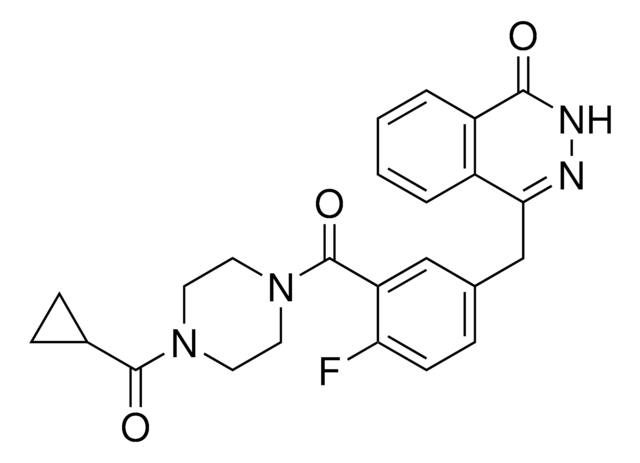P4365
PJ-34 hydrochloride hydrate
≥98% (HPLC), powder
Synonym(s):
PARP Inhibitor VIII, PJ 34 HCl, N-(6-Oxo-5,6-dihydrophenanthridin-2-yl)-(N,N-dimethylamino)acetamide hydrochloride
About This Item
Recommended Products
Quality Level
assay
≥98% (HPLC)
form
powder
storage condition
desiccated
color
white to yellow
solubility
H2O: 22 mg/mL
SMILES string
Cl[H].[H]O[H].CN(C)CC(=O)Nc1ccc2NC(=O)c3ccccc3-c2c1
InChI
1S/C17H17N3O2.ClH.H2O/c1-20(2)10-16(21)18-11-7-8-15-14(9-11)12-5-3-4-6-13(12)17(22)19-15;;/h3-9H,10H2,1-2H3,(H,18,21)(H,19,22);1H;1H2
InChI key
YCALIZUKAFUQCH-UHFFFAOYSA-N
Application
- as a poly(ADP-ribose) polymerase (PARP) inhibitor 1 in rats to test the effect of PAPR1 in neuropathic pain
- as a component of protein extraction buffer to enable visualization of the high-molecular-weight smear of PARylated proteins in various cell samples
- as PARP inhibitor in murine MLE-12 epithelial cell line
Biochem/physiol Actions
Storage Class
11 - Combustible Solids
wgk_germany
WGK 3
flash_point_f
Not applicable
flash_point_c
Not applicable
ppe
Eyeshields, Gloves, type N95 (US)
Certificates of Analysis (COA)
Search for Certificates of Analysis (COA) by entering the products Lot/Batch Number. Lot and Batch Numbers can be found on a product’s label following the words ‘Lot’ or ‘Batch’.
Already Own This Product?
Find documentation for the products that you have recently purchased in the Document Library.
Our team of scientists has experience in all areas of research including Life Science, Material Science, Chemical Synthesis, Chromatography, Analytical and many others.
Contact Technical Service







